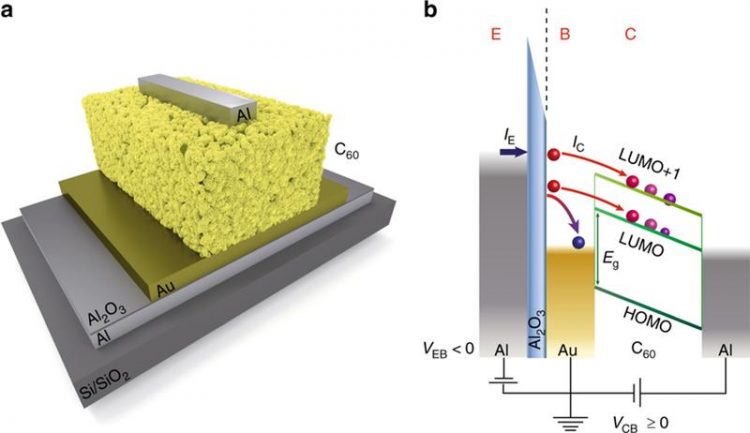Marcus regime in organic devices: Interfacial charge transfer mechanism verified

Device schematics. a – Schematic cross section of the device. b – Hot-electron transistor operation. Electrons are injected by applying a negative emitter-base bias, and detected in the molecular semiconductor. These electrons are out of equilibrium with the thermal electrons in the base which cannot be described by a larger temperature. The measurements can be performed either without or with externally applied collector-base bias. Frank Ortmann
Charge transfer processes play a fundamental role in all electronic and optoelectronic devices. For devices based on organic thin-film technology, these include the injection of the charge carriers via the metallic contacts and the charge transport in the organic film itself.
Injection processes at the contacts are of particular interest here because the contact resistances at the interfaces must be minimized for optimum device efficiency. However, such internal interfaces are difficult to access and therefore not yet understood very well.
The team of cfaed research group leader Frank Ortmann (Computational Nanoelectronics Group), together with researchers from Spain, Belgium and Germany, has now shown in a study that the electronic transport mechanism when injected into an organic film can be described by the so-called Marcus hopping model known from physical chemistry.
The model was developed by the American chemist Rudolph Arthur Marcus. Comparative theoretical and experimental investigations unequivocally identified the transport regimes predicted in the Marcus theory.
“The predictions derived by R.A. Marcus in the context of chemical synthesis in the 1950s, in particular the so-called 'inverted Marcus regime', could only be confirmed many decades later by systematic experiments on chemical reactions. For his important theoretical contributions, R.A. Marcus received the Nobel Prize for Chemistry in 1992 “, says Ortmann.
“Now, the observation of the 'Inverted Marcus Region', in which a higher voltage generates a lower current, succeeded for the first time in an organic transistor, in which the injection voltage can be actively controlled”, Ortmann continues.
This leads to a better understanding of electronic and optoelectronic organic devices in general. The publication has been published on 7th May, 2019 in the journal “Nature Communications”.
About the Computational Nanoelectronics Group
The research group at the Center for Advancing Electronics Dresden (cfaed) headed by Dr. Frank Ortmann investigates electronic properties and charge transport properties of novel semiconductor materials.
Here, organic semiconductors are currently an important focus of the work, which is funded by the German Research Foundation under the Emmy Noether Program. The group has been based at the cfaed since 2017.
Press picture:
HiRes download: https://bit.ly/2Lulciy
Caption: Device schematics. a – Schematic cross section of the device. b – Hot-electron transistor operation. Electrons are injected by applying a negative emitter-base bias, and detected in the molecular semiconductor. These electrons are out of equilibrium with the thermal electrons in the base which cannot be described by a larger temperature. The measurements can be performed either without or with externally applied collector-base bias.
Media inquiries:
Matthias Hahndorf
Center for Advancing Electronics Dresden, TU Dresden
Head of Communications
Tel.: +49 351 463-42847
Email: matthias.hahndorf@tu-dresden.de
Dr. Frank Ortmann
Center for Advancing Electronics Dresden, TU Dresden
Group Leader Computational Nanoelectronics Group
Tel.: +49 (0)351 463 43260
E-Mail: frank.ortmann@tu-dresden.de
Paper title: “Tuning the charge flow between Marcus regimes in an organic thin-film device” (Nature Communications)
Web: https://www.nature.com/articles/s41467-019-10114-2
DOI: 10.1038/s41467-019-10114-2
Authors: A. Atxabal, T. Arnold, S. Parui, S. Hutsch, E. Zuccatti, R. Llopis, M. Cinchetti, F. Casanova, F. Ortmann, L.E. Hueso
Media Contact
All latest news from the category: Physics and Astronomy
This area deals with the fundamental laws and building blocks of nature and how they interact, the properties and the behavior of matter, and research into space and time and their structures.
innovations-report provides in-depth reports and articles on subjects such as astrophysics, laser technologies, nuclear, quantum, particle and solid-state physics, nanotechnologies, planetary research and findings (Mars, Venus) and developments related to the Hubble Telescope.
Newest articles

Peptides on Interstellar Ice
A research team led by Dr Serge Krasnokutski from the Astrophysics Laboratory at the Max Planck Institute for Astronomy at the University of Jena had already demonstrated that simple peptides…

A new look at the consequences of light pollution
GAME 2024 begins its experiments in eight countries. Can artificial light at night harm marine algae and impair their important functions for coastal ecosystems? This year’s project of the training…

Silicon Carbide Innovation Alliance to drive industrial-scale semiconductor work
Known for its ability to withstand extreme environments and high voltages, silicon carbide (SiC) is a semiconducting material made up of silicon and carbon atoms arranged into crystals that is…





















